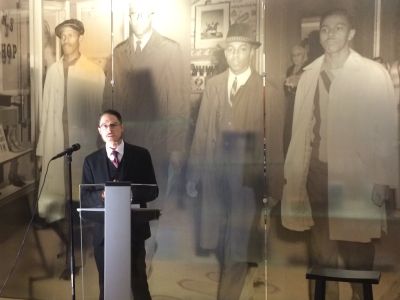
MUSEUM STUDIES
States of Incarceration: A National Dialogue of Local Histories

By Joshua Dacey
In the fall of 2015, ten UNCG History Museum Studies masters candidates were tasked with connecting contemporary audiences to the history of chain gangs in North Carolina. I consider myself fortunate enough to be counted among these ten individuals. Under the guidance of Dr. Christopher Graham and Dr. Anne Parsons, we have collaborated with nineteen other universities nation-wide to curate a traveling exhibition focusing on the issues surrounding mass incarceration. The States of Incarceration exhibition offers visitors a unique experience beyond historical dialogue. Each contributing university was assigned a "local question" exploring a specific topic relating to mass incarceration prevalent in their community. Our project began by researching the conditions of chain gang labor in 1920s North Carolina. We examined prisoners' letters and state documents to understand the myriad abuses convicts endured in the labor camps. Our goal was to highlight the "Voices From The Chain Gangs" in an exhibit panel. Through text labels, historic photographs, and excerpts from the prisoners' letters, the audience is asked "What Can We Learn From Listening?" Each component of our panel attempts to evoke hope, passion, urgency, fear, loss, justice, and empathy. These are universal concepts that we identified as relevant and meaningful in the exhibition.
The States of Incarceration exhibition debuted in April at the New School in New York City. For the next two years, the panels and the stories they hold will travel across the country. In November, the exhibition will be coming to the International Civil Rights center and Museum in Greensboro. In partnership with the National Endowment for the Humanities, a series of public programs will focus on creating dialogue with the Greensboro community. The UNCG students who curated a part of the exhibit will offer tours, giving insight on the development experience, and discussing how the history of incarceration fostered new perspectives. Individuals who have been directly affected by mass incarceration will also guide visitors on tours, sharing their unique perspectives and facilitating discussion about the issues highlighted throughout the exhibit.
Our experiences in developing exhibition content, creating public programs, and designing special tours, provided insight into the interpretation of controversial subjects. Our challenges and successes have proved to be a valuable learning experience focalizing on community inclusion and fostering dialogue surrounding the issues of mass incarceration. One of the most challenging issues museum professionals have faced in recent decades is relevancy. On a daily, even hourly basis, we have to ask ourselves "how is this exhibit, program, or content relevant to our society? Can it affect change? Will our visitors care?" These questions can evoke frustration in even the most seasoned public historians. After all, if our work is not relevant to the communities we serve, what�s the point? Throughout the past eighteen months, we have been constantly reminded that the most effective way to serve our audience is through our capacity to act with compassion and understanding. This project would not have been possible without the support of the UNCG History Department and the Greensboro community. I personally want to thank my cohort, Dr. Christopher Graham, and Dr. Anne Parsons.